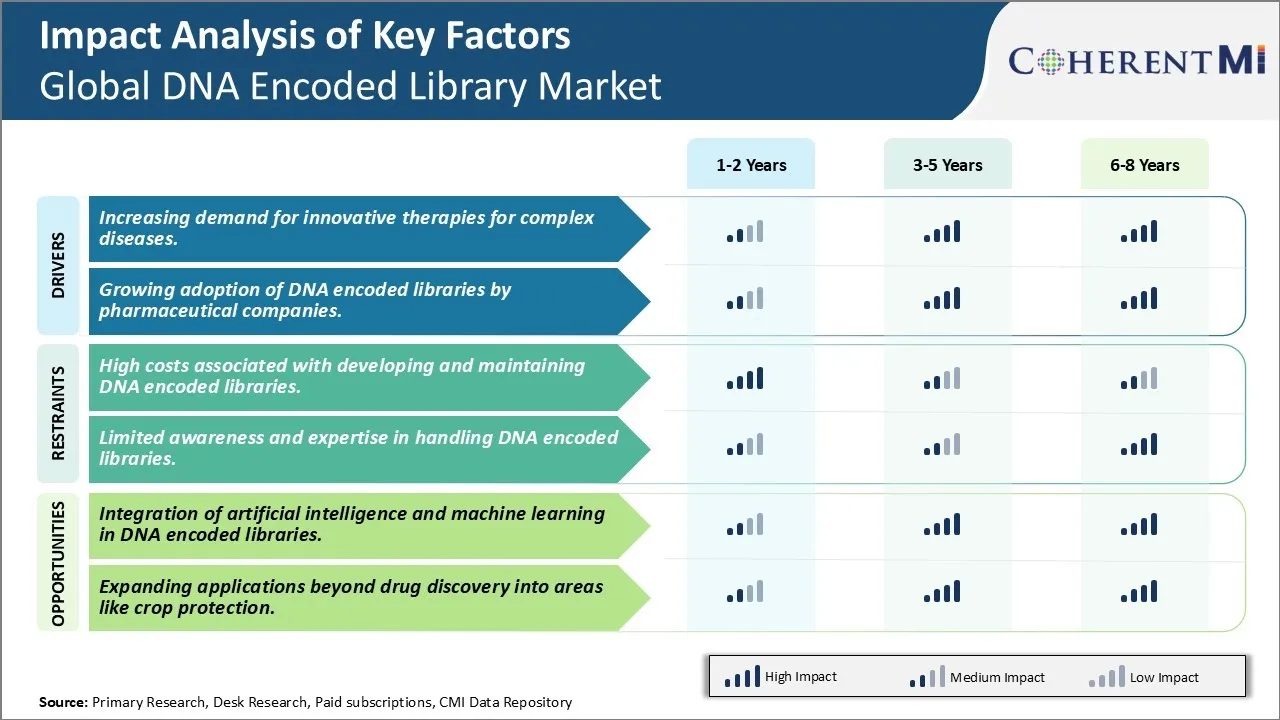Global DNA Encoded Library Market Trends
Market Driver - Increasing demand for innovative therapies for complex diseases
The healthcare sector is constantly evolving to address the growing threat of complex diseases. Traditional methods of drug discovery are often unable to keep up with the pace of emerging illnesses. This has created a sizable gap in effective treatment options for conditions like cancer, autoimmune disorders, and rare genetic maladies. Patients desperately need novel therapies that can target the root causes with greater specificity and fewer side effects. DNA encoded libraries have emerged as a promising solution to fulfill this increasing demand.
By allowing rapid screening of millions of drug-like small molecules in parallel, DNA encoded libraries give researchers an unprecedented level of experimental throughput. This accelerates the discovery of hits that engage disease targets in precise ways. Researchers can now evaluate molecular interactions across entire biological pathways as opposed to focusing on just individual proteins. This systems-level approach presents new opportunities to address complex multi-factorial conditions by modulating multiple nodes simultaneously. DNA encoded libraries also enable evaluation of compounds that were previously inaccessible through conventional synthesis methods, expanding the potential chemical space for novel treatment options.
Clinicians, care providers, and patient advocates actively campaign to accelerate the development and approval of advanced therapeutics that improve outcomes and quality of life. Their voices help shape policy reforms and increase public/private investments in innovative research. As diseases continue spreading to growing populations worldwide and overcoming traditional drugs, society expects biopharma to rise up and fulfill this need through cutting-edge strategies like DNA encoded libraries. Their ability to efficiently explore vast pools of synthetic and natural compounds positions them at the forefront of next-generation precision medicine efforts aimed at complex diseases. This confluence of societal pressures and scientific promise will continue driving increased adoption of the technology.
Growing Adoption of DNA Encoded Libraries by Pharmaceutical Companies
The pharmaceutical industry is under constant pressure to replenish dwindling pipelines as many major drugs lose patent protection each year. Developing novel therapeutics is a resource-intensive process often taking over a decade with extremely low odds of success. Companies are eager to integrate emerging techniques that can hasten the journey from target identification to clinical candidates. DNA encoded libraries are garnering strong interest from industry players for their unique capability to rapidly generate high-quality lead molecules against challenging targets.
Contrary to conventional high-throughput screening technologies relying on synthesized small-molecule collections, the flexibility of DNA encoded libraries allows exploration of exponentially larger and more diverse chemical space in parallel. Pharma R&D centers are able to perform multiplexed experiments involving millions of compounds in a cost-effective manner. Initial library configurations may focus on privileged structures or natural product-like scaffolds to increase hit rates against difficult targets. DNA encoding further enables late-stage compound optimization and profiling directly within the library format itself without separate synthesis.
Major players like AstraZeneca, Novartis, Sanofi, and Janssen have already begun establishing internal DNA libraries and developing associated expertise. Contract research organizations specializing in the technology are also witnessing a surge in pharma collaborations and outsourced projects. Over time, DNA encoded library screenings are expected to become a standard first-pass evaluation strategy incorporated earlier into drug development workflows. Emerging applications going beyond simple target engagement now involve in vivo animal studies, biomarker analyses, and resistance profiling. As successful proof-of-concept studies establish real-world clinical and commercial validation, adoption rates within the industry are poised to rapidly accelerate.

Market Challenge - High costs associated with developing and maintaining DNA encoded libraries
One of the key challenges currently facing the global DNA encoded library market is the high costs associated with developing and maintaining DNA encoded libraries. Creating DNA encoded libraries at scale requires significant investments in technology, infrastructure and skilled personnel. The process of developing a DNA encoded library starts with designing and synthesizing large pools of compounds that are then attached to DNA tags through chemical ligation. This process of creating millions to billions of DNA-encoded molecules is complex and resource intensive. It involves the use of expensive DNA synthesizers, reagents and other laboratory equipment. Maintaining and screening DNA encoded libraries over time also leads to continuous costs. As libraries are used in assays and experiments, some molecules may degrade or get lost, requiring replenishment or expansion. Libraries also need to be characterized regularly to ensure diversity and quality are maintained. All these activities associated with developing, refining and upkeeping DNA encoded libraries over the long term make it a costly endeavor for players in this market. The high capital requirements pose a major challenge, especially for smaller companies and startups with limited budgets. This cost barrier could potentially limit further innovation and growth in applications of this promising technology.
Market Opportunity- Opportunities through Integration of artificial intelligence and machine learning in DNA encoded libraries
One of the key opportunities in the global DNA encoded library market is through greater integration of artificial intelligence and machine learning technologies. As DNA encoded library datasets continue to grow in size and complexity, there is potential to leverage AI/ML to help optimize the libraries and discovery processes. AI/ML algorithms could be used to glean insights from vast amounts of sequencing and screening data. They could help recommend new compounds for synthesis, refinement of library design, and prognostication of biologically relevant molecules. As assays become higher throughput, AI/ML models may assist with automated analysis of large output datasets. They could also power in silico screening to propose molecules for experimental validation. Pharmaceutical companies are also exploring using AI/ML approaches like generative models to propose entirely new DNA encoded libraries. If successfully applied, AI/ML technologies have the potential to make library design and candidate selection more efficient. This could help accelerate discovery timelines and lower costs. Increased AI/ML integration therefore presents an opportunity for the DNA encoded library market to enhance the entire workflow from creation to downstream applications.